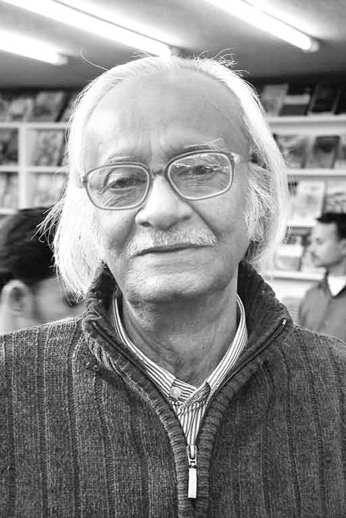
‘I have one more word to say’
Nilratan Halder | Saturday, 6 December 2014

Of the few artists who breathed art, lived in art and dreamed of art soaked in the very sustaining fluid of the soil, Qayyum Chowdhury was definitely one. The country's simple beauty and vibrancy was so exquisitely delineated in his paintings that his craftsmanship left an indelible mark on all of those. His love for art, the country and its culture, particularly the unalloyed folk brand, mingled together to give him his specialty. He developed his own style out of it. A man so steeped in the land's cultural mooring the master painter had his presence almost axiomatic where its art and culture met together to charge life with refreshing vigour.
No wonder, therefore, that he breathed his last on the stage of the Bengal Classical Music Festival on Sunday last. He delivered his speech as the special guest on that night and immediately came back to add, as he put, "I have one more word to say". Before he could utter that very 'one more word', the forerunner of the country's art and culture collapsed. So did his predecessor Qamrul Hasan in 2003 on the stage on the second day of the poetry recital session held every year on February 1 and 2. The similarity between their last journey from this world to the beyond is striking indeed. Patua Kamrul, as the other maestro was known to the world, was equally passionate about the land, its people, its culture and ethos. It is because of his commitment, he portrayed the monster out of Pakistan's most hated president and general Yahya Khan. Later he created the satirical face of autocrat Ershad. Qayyum, on the other hand, was not so politically vociferous in the wide sweep of his brush and colours; rather a sublime devotion mixed with generous sunshine rendered his work so captivating. Both men seem to have been inspired by Jamini Roy and yet they charted a course of their own with distinction.
An avid music lover, Qayyum in his speech on the night expressed his optimism that love for classic music as expressed by the young generation is a most positive sign and it has the capacity to elevate them on a higher plane of mind. He could not be more correct in his observation. Then what was left unsaid by him? Did he want to make an appeal to them who, belying all expectations, thronged at the Army Stadium, the venue of the five-day music fest, in their thousands. The artist surely had no personal demand. He loved the land and each of his paintings and illustrations bears testimony to that fact. His paintings and illustrations breathe through them the beauty and spirit of a most enchanting Bangladesh in its pristine setting but through master strokes and Qayuum-like style.
Simple in demeanour, the artist has unequivocally expressed his indebtedness to the unknown folk artists or artisans whose form and style inspired his work. But Qayyum has made it amply clear that it was none other than his mentor and teacher Jainul Abedin who actually helped open his eyes to the folk art. His instinctive appreciation of such art was completed by his teacher's guidance. But unlike his teacher he played with colour in its mutinous best. He believed that mere painting excellent pictures does not make one a good painter or artist. One must as well have the capacity to develop taste for songs and music, drama and cinema of the finest genres. What he left unsaid on this score is that above everything else one must possess a golden heart. The ability to break form, discover the unknown in the known as Picasso did in the art of the dark continent, Africa that is, is not all. One must strive to be a simple man with an innocent heart.